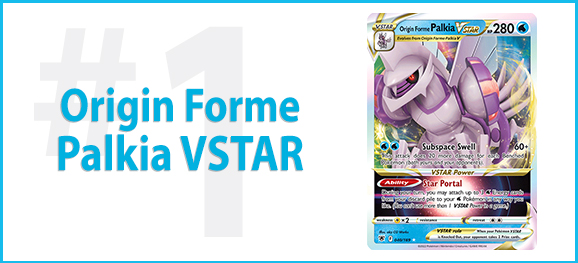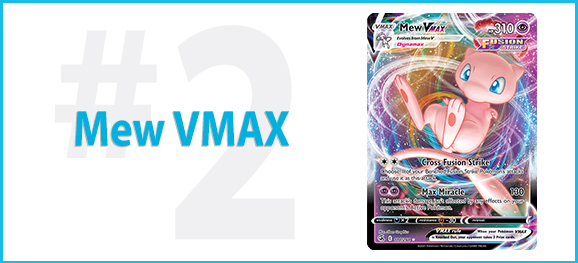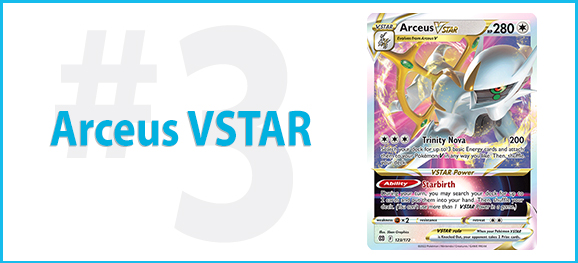Our panelists lay out the top decks to watch for in Columbus.
As the 2022
Pokémon TCG North America International Championships approach, one thing
is becoming clear, and it’s that the metagame is anything but. There’s a
whole slew of decks being tested that could easily come out on top in Columbus.
Two new Pokémon from the new Sword
& Shield—Astral Radiance expansion, Origin Forme Palkia VSTAR and
Hisuian Samurott VSTAR, at the center of two of the decks, adding some
disruption to an already volatile scene.
Fortunately, we’ve once again assembled our Power Rankings
panel to make a convincing case for five of the decks we’re most likely to see
when the action kicks off on June 24. Plus they add some of their own thoughts
about what could happen throughout the weekend.
Remember that you can catch NAIC action at Twitch.tv/Pokemon June 24–26.

Origin Forme Palkia VSTAR is the rising star of
the new Sword & Shield—Astral Radiance expansion, and it’s looking
to seriously shake up the metagame. It comes with an attack that is very
reminiscent of Suicune V,
a card which was already featured on our previous Power Rankings, but with
significantly more base damage and HP. Like Suicune V, Origin Forme Palkia
VSTAR will match up perfectly with the incredible Inteleon
engine. It not only gives the deck access to exactly the cards it needs
every turn, but also acts as a strong secondary attacker due to its Water
typing. Origin Forme Palkia VSTAR also has a great VSTAR Power in Star Portal that
gives the Pokémon a lot of freedom and flexibility when choosing its attackers.
One inclusion we are surely going to see in most its decks
is the new Radiant Greninja.
It can take two Knock Outs at once, which is devastating against other
Inteleon-based decks, in addition to providing draw power with its Concealed
Cards Ability.
On paper, Origin Forme Palkia VSTAR has everything it needs
to compete at the highest level. Will it live up to the expectations at the
North America International Championships, or will Mew VMAX and Arceus VSTAR
defend their spots as the best decks of the format? We will likely see
an increase in play of Lightning-type Pokémon, similar to how many decks try to
counter Mew VMAX with Darkness types. Despite that, I won’t be surprised if
Origin Forme Palkia VSTAR ends up being the winning deck. — Robin Schulz

It should be no surprise to see Mew VMAX return for this edition of the International
Championship Power Rankings. The deck is designed to quickly power up and do
loads of damage with Meloetta and
Mew VMAX, and does so consistently by using Genesect V‘s Fusion Strike System ability. It is regarded
as the touchstone of competitive viability for all emerging archetypes.
Despite this, Mew VMAX has not secured many victories at
major events. Perhaps the deck has become the victim of its own popularity—every
competitor enters battle with a strategy and some tech cards to defeat the
Fusion Strike combination. However, with attention turned to Origin Forme Palkia VSTAR and
other decks arising from Sword & Shield—Astral Radiance, it is
likely that Mew VMAX will now face fewer direct counters on the path to
victory.
If you’re still in doubt, remember that Mew VMAX also gains
some new resources from the latest set. Trekking Shoes enables competitors to discard cards like Battle VIP Pass and Elesa’s Sparkle when they are
longer useful in the match, and the Supporter card Cyllene can recover Fusion Strike Energy, thereby extending the longevity of
Meloetta as a powerful attacking option. — Ellis Longhurst

Gengar VMAX,
Lucario VSTAR, Hoopa V, Gyarados VMAX, Duraludon VMAX, Beedrill, and Medicham V all have one thing in
common: they all appeared in the finals of a Regional Championship in the past
three months while partnered with Arceus VSTAR.
This is a testament to the incredible versatility of this already iconic card
from Sword & Shield—Brilliant Stars. With so many strong placements
in recent events, it’s hard to imagine that Arceus VSTAR won’t be a part of the
Sword & Shield—Astral Radiance metagame, even accounting for new
powerful decks, such as Origin Forme Palkia VSTAR.
In fact, Arceus VSTAR may well find even more partners, such as Tapu Koko VMAX, in order to
combat this new threat.
Each Arceus VSTAR variant has its upsides, but the one
that’s likely to be the most popular and perhaps the most effective is the most
straightforward and consistent one: Arceus VSTAR/Inteleon.
Thanks to Drizzile and
Inteleon’s Shady Dealings Ability and Arceus VSTAR’s Starbirth, this deck can
easily find any of its situational cards at any point in the game. The newest
such card is Roxanne,
which gives it better odds to come back from difficult situations, especially
combined with Path to the Peak to
limit the opponent’s options.
Arceus VSTAR/Inteleon may not be the flashiest deck around,
but that might be precisely what helps it. If players are too focused on
countering Mew VMAX and Origin
Forme Palkia VSTAR at NAIC, there’s a serious chance that Arceus VSTAR will end
up winning the tournament instead. — Stéphane Ivanoff

At this point it’s safe to say that Rapid Strike Urshifu VMAX has
stood the test of time. G-Max Rapid Flow has proven to be one of the absolute
strongest attacks in the game. From its initial release in Sword &
Shield—Battle Styles, it quickly became one of the frontrunners of the
meta. With every expansion released since, Rapid Strike Urshifu VMAX has
encountered new challenges and hurdles that forced it to adapt. The most recent
threat that was expected to seal Rapid Strike Urshifu VMAX’s faith for the
remainder of the format is the Fusion Strike Mew VMAX
deck. Somehow, the Rapid Strike Urshifu VMAX builds adapted to include
numerous Darkness-type attackers to deal with the psychic-type Pokémon.
The current and most successful iteration of the Rapid
Strike Urshifu VMAX deck features an extreme number of single copies of cards,
giving the deck a wide array of options. Normally, including so many different
copies of cards is not something players voluntarily seek, but thanks to the
Shady Dealings Ability provided by the Inteleon
engine, the deck operates like a well-oiled machine. With options
provided by the likes of Medicham V‘s
Yoga Loop attack, and Supporter cards like Cheryl,
the deck does not lack comeback options either, and can turn almost any game
around in an instant. Being able to hit one of the most popular decks in the
format, Arceus VSTAR,
for Weakness is also a huge selling point for the archetype.
Rapid Strike Urshifu VMAX variations are currently among the
most difficult decks to play and build in the format, and I’m excited to see
how the deck will continue to adapt heading into the North American
International Championships! — Tord Reklev

Our rankings for NAIC is bookended by a pair of new
contenders from Sword & Shield—Astral Radiance, and that’s often how
it seems a new expansion contributes to the Standard format. While Origin Forme Palkia VSTAR has
been the focus of immense hype, Hisuian Samurott VSTAR is a bit more under-the-radar. It’s one of
my favorite cards from the set, though, because of the flexibility and Energy-efficient
heavy damage it offers.
It’s fortunate to enter a format where the “shell” it needs
to succeed is already pretty clearly defined: Galarian Zigzagoon is the most obvious fit for setting up a
Merciless Blade, but Inteleon
is another clear choice. Conveniently, Drizzile
and Inteleon are
merely some of the most heavily played cards in the game’s history, forming a
consistency engine that might be the all-time best. With Choice Belt, Galarian Zigzagoon/Inteleon, and options such as Radiant Hawlucha, hitting the
“magic numbers” (e.g. the 280 HP that Origin Forme Palkia VSTAR and Arceus VSTAR share) becomes
shockingly easy.
More importantly, Darkness is a well-supported type: Dark Patch is making a
triumphant return, meaning we can setup multiple Hisuian Samurott VSTAR with
ease. Galarian Moltres is
another of my favorite cards right now, and it fits naturally here. Another
dimension: I bet Cheryl is
workable with the Inteleon engine, giving an option of extra bulk that makes
the strategy even stronger. To me, Hisuian Samurott VSTAR is the center of the
show, but it’s the strong supporting cast that gives it immersive potential for
NAIC. Personally, it comes in above the #5 ranking we landed on here, and I’m
expecting a strong showing. — Christopher Schemanske
Ellis Longhurst: The North America International
Championships always attracts a huge number of competitors from around the
world. In fact, the 2018 event holds the record for the most competitors in the
Masters Division at an International Championships: 1534! The year will likely
be just as busy, and with so many competitors in attendance, you may be
wondering which players to keep a close eye on.
There is a lot of hype surrounding [fellow Power Rankings
panelist] Stéphane Ivanoff. Having won this event in 2018 and 2019, Stéphane is
battling to become the first competitor to successfully defend an International
Championship title twice. I’ll also be following the progress of Travis
Beckwith, who holds a spot near the top of the leader board for the North America
region. Travis is one of the competitors new to the Masters Division who are
out to prove that they should not be discounted for their age.
This is the last opportunity for competitors to earn
Championship Points and secure their place at the 2022 World Championships, so
there are sure to be plenty of other exciting storylines to follow. Make sure
you tune in to all the action as it unfolds live on stream.
Christopher Schemanske: Will any of the new Pokémon
VSTAR be able to dethrone Arceus as the center of the Pokémon TCG universe? As
you see here, we like Origin Forme Palkia VSTAR‘s
chances, but it’s hard to bet against Arceus VSTAR; I don’t think I can remember any other
Pokémon enabling such a diverse array of competitive strategies around it. Mewtwo-EX is the closest I
can remember a Pokémon coming in terms of sheer domination, but where Mewtwo-EX
simply spawned a variety of strategies looking attach Energy to itself as
quickly as possible, Arceus VSTAR facilitates a variety of bona fide
alternative strategies. In 2012, I played many entire games where X Ball was
the only attack either player used, but in 2022, that’s not remotely true of
Trinity Nova.
Personally, Arceus VSTAR represents the best form of
centralization we can ask for in the metagame: each variant may have a similar
core strategy, but the consistency offered by Starbirth allows players to do
immensely different things. Arceus VSTAR/Inteleon/Beedrill is an entirely different
deck than Arceus VSTAR/Malamar VMAX/Jolteon—which is an entirely different
deck than Arceus VSTAR/Gyarados VMAX—yet,
all three of those decks have been successful in the last few weeks!
Origin Forme Palkia VSTAR, Hisuian Samurott VSTAR, and Darkrai VSTAR are all pretty
strong contenders, but I don’t know if I fully believe that Arceus VSTAR is
going to be dethroned.
Stéphane Ivanoff: All the decks in our top five rely
on Pokémon VMAX or VSTAR attackers. What about single-Prize Pokémon, you may
ask? Sword & Shield—Astral Radiance adds a couple of them to the
metagame.
Regigigas,
which relies on a full-board of high-HP Basic Pokémon, is fairly popular. I
don’t think it will match up well enough against the metagame’s top tier decks,
but it’s still a strategy to watch out for.
Other players may enjoy Miltank
instead, whose Miracle Body Ability protects it from damage from Pokémon
V. It’s not a perfect counter to the metagame: Mew VMAX can still Knock Out Miltank with Max Miracle,
while other decks will attack with Inteleon
instead of a Pokémon V. However, it is a Pokémon that can completely
wall some decks, so players will definitely need to consider it while building
their decks.
Finally, I believe that Hoopa/Galarian Moltres and Galarian Moltres V/Inteleon has a
chance to shine at this event. This deck relies on Basic attackers in order to
take Prize cards throughout the game. Adding Raikou V
or Zeraora gives
the deck a way to hit Origin Forme Palkia VSTAR
for Weakness, and Hisuian Heavy Ball
all but guarantees that in each matchup, you can use the most
appropriate attacker, even if it’s Prized.
Robin Schulz: The North American International
Championships are expected to be the biggest event of the year, and as usual,
there’s a lot of interesting storylines to follow! Will fellow Power Rankings
panelist Stéphane Ivanoff be able to achieve the impossible and take the
tournament for a third time in a row? Will we see the first American champion
on home ground after a series of winners from Europe? Will there be breakout
performances from players that started during the online era of the past two
years?
As the last tournament before the World Championships, there
are also many questions about Invites and top ranking spots to be answered.
There’s a lot on the line for players and I’m excited to see how it all plays
out!
Besides the players’ stories, I think we’re also in a very
interesting spot in the format. There are many different and interesting decks
to choose from, and no clear best one yet. Could we see one deck rise to the
top and dominate the competition, like Rapid Strike Urshifu VMAX did earlier this year at the European
Championships? Tune in to the stream to find out!
Tord Reklev: I think the question on everyone’s mind
heading into NAIC will be how big of an impact the Sword & Shield—Astral
Radiance expansion will have on the metagame, and how much the Origin Forme Palkia VSTAR deck
should be respected. The new Radiant cards are also incredibly powerful, and we
should expect to see most decks try to utilize one of them. Radiant Greninja looks to be the
most versatile Radiant Pokémon so far, but I would not be surprised to see Radiant Hawlucha, or even Radiant Heatran being featured.
Another card I think will have a great impact on the format
is Roxanne. Ever since Reset Stamp rotated out, the most
powerful hand disruption option has been Marnie.
Marnie is a card that can be played at any point in the game, but it does not
reliably stop the opposing player from doing what they want on the following
turn. Roxanne on the other hand leaves the opponent at two cards before their
turn instead of four. The difference is massive and has way fewer counter plays
as Roxanne shuffles both players decks. Players could prepare against Marnie by
using Oranguru‘s Primate
Wisdom Ability, or even the Switching Cups
Item card.
The presence of Roxanne in the format could again make
players think twice before knocking out a Pokémon. Sometimes, delaying a
knockout to prevent Roxanne will be huge, and I am excited to have such a
powerful hand disruption card present in the format once again.
Don’t forget to watch exciting matches at the North America International Championships from June 24–26 on Twitch.tv/Pokemon.
About the Writer

Stéphane Ivanoff
Stéphane Ivanoff is a contributing writer for Pokemon.com. A longtime Pokémon fan, he has played the Pokémon TCG competitively since 2010 and is a former National Champion, seven-time Worlds competitor, and the 2018 and 2019 North America International Champion in the Masters Division. He studied mathematics and has a degree in Probability and Statistics, but he says that doesn’t help his game as much as you’d think! You can follow him on Twitter @lubyllule.

Source: Pokemon

